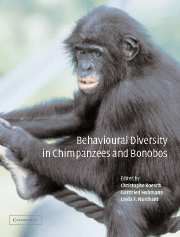Book contents
- Frontmatter
- Contents
- List of contributors
- Preface
- Behavioural Diversity in Pan
- PART I BEHAVIOURAL FLEXIBILITY
- PART II SOCIAL RELATIONS
- INTRODUCTION
- 6 Factors influencing fission–fusion grouping in chimpanzees in the Taï National Park, Côte d'Ivoire
- 7 Ecological and social correlates of chimpanzee party size and composition
- 8 Agonistic relations among Kanyawara chimpanzees
- 9 Relationships of male chimpanzees in the Budongo Forest, Uganda
- 10 Dynamics in social organization of bonobos (Pan paniscus)
- PART III FEMALE STRATEGIES
- PART IV HUNTING AND FOOD SHARING
- PART V GENETIC DIVERSITY
- Index
10 - Dynamics in social organization of bonobos (Pan paniscus)
Published online by Cambridge University Press: 08 February 2010
- Frontmatter
- Contents
- List of contributors
- Preface
- Behavioural Diversity in Pan
- PART I BEHAVIOURAL FLEXIBILITY
- PART II SOCIAL RELATIONS
- INTRODUCTION
- 6 Factors influencing fission–fusion grouping in chimpanzees in the Taï National Park, Côte d'Ivoire
- 7 Ecological and social correlates of chimpanzee party size and composition
- 8 Agonistic relations among Kanyawara chimpanzees
- 9 Relationships of male chimpanzees in the Budongo Forest, Uganda
- 10 Dynamics in social organization of bonobos (Pan paniscus)
- PART III FEMALE STRATEGIES
- PART IV HUNTING AND FOOD SHARING
- PART V GENETIC DIVERSITY
- Index
Summary
INTRODUCTION
In the last 20 years, chimpanzee (Pan troglodytes) and bonobo (Pan paniscus) research has produced contrasting pictures of these two sister species. Chimpanzee society has been characterized as male dominated and structured by a linear hierarchy amongst males, with more egalitarian relations amongst females. Male dominance rank is often based on alliances with other males and exerted by intense aggression (Riss & Goodall 1977; Goodall 1986; McGrew 1996; Watts 1998). Parous females, except when they are in oestrus, tend to avoid travelling with males in order to prevent aggression and to improve their foraging efficiency (Williams et al., Chapter 14; Wrangham, Chapter 15). Consequently, parties are relatively small and often male biased (Nishida 1979; Wrangham 1986; Wrangham et al. 1992; Boesch & Boesch-Achermann 2000). In comparison, bonobo society is characterized by egalitarian relations between the sexes (Furuichi 1997) and females may collaborate to defend food sources against males (Idani 1991; Parish 1994; Hohmann & Fruth 1996;Vervaecke et al., 2000). Males establish dominance relationships with each other but aggression amongst males and between the sexes is less intense than in chimpanzees, and conflicts are often settled in a non-agonistic way (Furuichi & Ihobe 1994; de Waal 1995). Compared to chimpanzees, bonobo parties are large and biased towards females. Recently, the behavioural contrasts between the two Pan species have been questioned (Stanford 1998) for various reasons. These include scarcity of information from wild bonobos, and the failure to compare data from wild chimpanzees with what is known from studies of captive bonobos. The goal of this chapter is to address these issues by providing new data on the social organization of wild bonobos.
- Type
- Chapter
- Information
- Behavioural Diversity in Chimpanzees and Bonobos , pp. 138 - 150Publisher: Cambridge University PressPrint publication year: 2002
- 95
- Cited by

